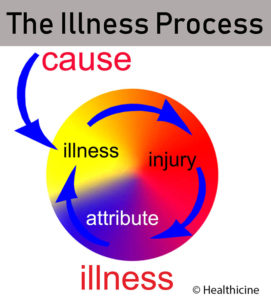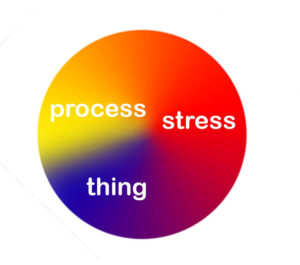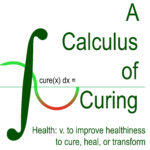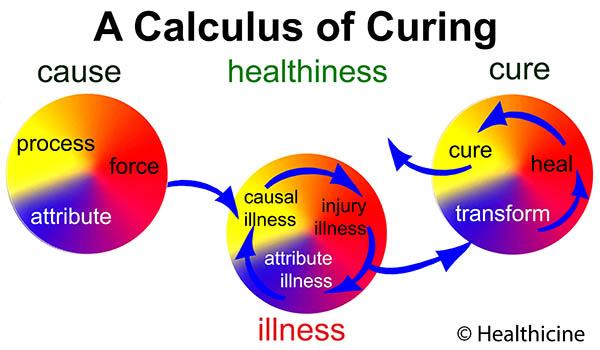
Illness and disease are natural processes. We can understand these processes better as we study the natural progressions of illness.
Every illness has a cause. An illness element, the simplest illness, has a single cause. Infections are caused by bacteria. Colds and flu are caused by a virus. Scurvy is caused by a dietary deficiency of Vitamin C.
The first stage of any illness has a single cause.
Everything should be made as simple as possible, but not simpler - Albert Einstein Share on XAn elementary illness has three parts:
- the cause
- the consequences, the signs and symptoms of illness
- the intersection of cause and consequences, such that we believe the cause has resulted in the consequences.
We cannot see the “illness”, we only see the signs and symptoms – and sometimes we can see the cause. Sometimes, the cause is invisible because it is a negative. Scurvy is a disease caused by the absence of Vitamin C in the diet. To understand the illness we must understand all three aspects, the cause, the consequences, and the intersection or interaction between the cause and the signs and symptoms.
In the first stage, an illness is cured by addressing the cause. Infections are cured with antibiotics. Scurvy is cured with a healthy diet. The common cold is cured by health, healing, and time.
Illness >>> Injuries: When an illness is not cured, it might progress to the second stage, causing injuries. The common cold can cause nosebleeds. More severe illnesses cause more severe injuries. Scurvy can cause injuries so severe they lead to death.
Injuries are cured by healing. When an illness progresses to the stage where it causes injuries, two cures are required, one to address the cause, and another to heal the injuries. Healing is initiated automatically by health – as soon as damage begins to occur.
Injuries >>> Negative Attributes: Sometimes an illness causes injuries which cannot be healed. Scurvy can lead to loss of teeth. Diabetes, when not cured, can lead to loss of limbs. Injuries that cannot be healed become negative attributes. Some negative attributes are permanent – like an amputated leg, or a scar from a wound. Sometimes, a negative attribute can be cured by transformation. Damaged teeth are cured by fillings and caps – dental transformations. Hernias are cured by surgical transformations. However, many negative attributes caused by illness are minor and the transformation can be much less severe than surgery. A dislocated shoulder or knee might be cured by the push of a friend, a coach, or a therapist.
Negative Attribute >>> Illness: A negative attribute that is not cured can lead to more illnesses. Damaged teeth can affect diet. A scar can impede movement, making the person susceptible to falls. A gangrenous leg caused by injuries, caused by diabetes, might lead to blood poisoning and death if not transformed by amputation.
Sometimes, a negative attribute can arrive without illness, and then proceed to cause illness. The cure is to transform the cause, the negative attribute, not the cause of the negative attribute. Cataracts caused by the natural forces of ageing are cured by a transformation, cataract surgery, not by addressing the cause of the cataracts.
Circle Of Illnesses
Any element in the circle of illnesses, when not addressed, when not cured, can progress around the circle, causing new illnesses.
Circles of Causes of Illness
 The cause of an illness can be a life process – or lack of life process, it can be a stress – or a lack of stress, or it might be a thing, an attribute – or a lack of an attribute.
The cause of an illness can be a life process – or lack of life process, it can be a stress – or a lack of stress, or it might be a thing, an attribute – or a lack of an attribute.
A cause of illness might come from body, mind, spirit, or community, and the cure might also come from body, mind, spirit, or community. A poor attitude might cause illness, that might be cured when the cause is transformed by a mental whack on the side of the head.
Causes of illness can enter the circle as any of the three illness types. Once an illness enters the circle it can progress forward and cause more illnesses until it is cured.
Circle of Cures
 Each illness is cured by reversing the circle:
Each illness is cured by reversing the circle:
Illnesses with an active cause are cured by addressing the cause.
Healing occurs even as the illness progresses, attempting to reverse the illness as the cause persists and after it is gone.
Attribute transformations, cures for negative attribute illnesses, often cause injuries, which must be healed.
Don’t be fooled by the concept of “placebo effects”. Placebo effects are real. Real effects have real causes. But there are no “placebo cures”. Every cure has a real cause as well.
Chronic Illness
Chronic illnesses are a result of chronic causes. Any cause can be chronic if it persists over time, and many causes – if not addressed – will persist over time, causing a chronic illness.
Chronic illnesses can only be cured by addressing the chronic nature of the cause. Directly addressing a single instance of the cause is insufficient to cure a chronic illness.
For example, an infection illness might be chronic if the patient is constantly exposed to infecting bacteria, or if their health is compromised such that infections can easily take hold. In these cases, it does little good cure an individual infection – the chronic cause must be addressed to cure the chronic illness.
Repetitive stress injuries are chronic, and cannot be cured by medicines nor by healing. They are only cured by addressing the cause, by removing the repetitive nature of the stress.
Attribute illnesses are chronic by nature because the cause is a thing, a noun, a physical, mental, spirit, community or environment attribute. Attribute causes persist because they exist, potentially causing more and more illnesses, until they are cured by transformation.
Source of Cause
Almost anything might be a cause of illness when excessive or deficient.
Causes of illness exist in the body, the mind, the spirit, the community, or the environment of the patient. Of course, most causes do not cause illness all of the time. Illness only occurs when cause interacts with the patient in some way to bring about an illness. Some symptoms and most diseases might have causes from many different sources and it is important to find the correct cause in order to cure. For example, depression can have a cause in the body – if the body is deficient in certain nutrients, depression will result. We might also view this case of depression as caused by the diet of the patient. Depression can also be caused by the mind, or the spirit, when a person gives up due to failures or failure to believe in themselves. Depression can be caused by gas lighting, a community cause. It can also be caused by toxic chemicals in diet or the environment.
How can we be sure we have found the cause? The illness is cured. However, when there exists more than one cause of a compound illness or disease, it can be difficult to determine that an individual illness element has been cured.
On the other hand, when the cause is not addressed, the illness will progress around the circle.
Illness Elements and Elementary Illnesses
This model of illness appears to be trivial. It is deliberately trivial because of the concept of elements of illness. Each element is a simple illness with a single cause. Success in curing illness depends on finding and curing elements of illness. This simplification provides a consistent view, a consistent path to all cures, as illnesses, become more complex.
Complex Illnesses
Complex illnesses occur when a single cause proceeds around the circle, causing other types of illness. An illness that also causes injuries requires two cures – one to address the cause and one to heal the damage. An illness that causes injuries that cannot be cured, that lead to negative attributes, requires three – or possibly more cures to address each element of illness.
Compound Illness
Each element of an illness has only one cause. A person with a single disease from three unique causes has three illness elements which are similar from the perspective of signs and symptoms, but not from the perspective of cause; a compound illness.
Compound illnesses require multiple cures. No single action can cure a compound illness, because no single action can address multiple causes.
Many of today’s diseases are compound illnesses. Chronic illnesses can easily become compound because we seldom attempt to cure chronic diseases. When we fail to cure or fail to attempt to cure, causes can accumulate, resulting in illnesses that are more difficult to cure.
Summary
An illness element is an illness with a single cause. Many illness elements are cured by health, or by natural healthy changes. The common cold is cured by health. Scurvy, or Vitamin C deficiency, might be cured without a diagnosis – by a change in diet made by accident without any intention to cure. As an illness becomes more and more complex, it becomes more and more difficult to cure.
An illness can become a complex illness if it is not cured, as it causes injuries and other illnesses.
Chronic illnesses have causes that persist over time. Chronic illnesses can arise from simple illnesses when the cause persists. They can also arise from causes that are not strong enough to cause a simple illness – but can cause chronic illness as damage accumulates over time. Sometimes different causes for the same illness accumulate, making cures more difficult because more cure actions are necessary to complete an illness or disease cure.
Compound illnesses have multiple causes, and require multiple cures. Compound illnesses are generally a result of failure to cure elementary illnesses. Compound illnesses can easily become chronic because they persist as more causes are added.
Health is the best medicine, health is the best cure. The Healthicine Creed. Share on X A Calculus of Curing
A Calculus of Curing
This material is based on the contents of the book: A Calculus of Curing. A much more comprehensive view of illness causes, processes and cures, as represented in the diagram below, can be found in the book.
You can learn more about the book here: How to Cure Any Disease.



